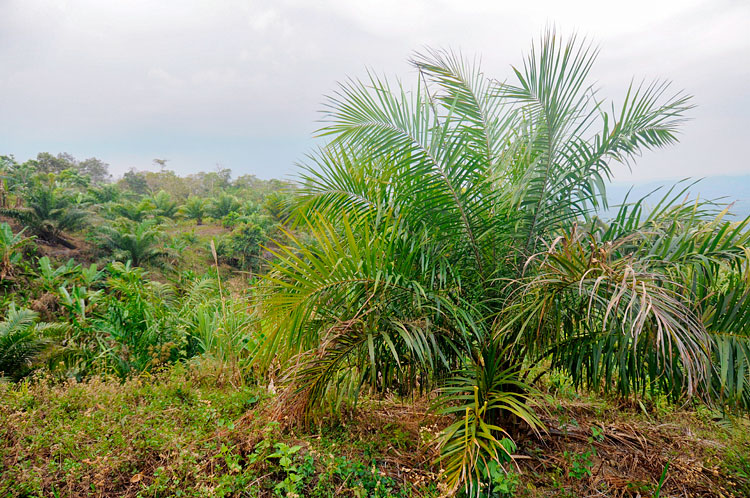A tweet from the Ministry of Environment, Forest and Climate Change (MoEFCC) reads – “Did you know? The total forest cover of India is 807,276 sq. km which is 24.56% of the geographical area of the country!”
When forest diversion and tree felling for development projects – roads, dams, mining, real estate and other infrastructure, are everyday news headlines, how could India continue its chest-thumping over forest cover, one wonders. Yet, every two years, there is a miraculous increase.
Imagine neatly planted rows of palm trees, running away to the horizon, spanning acres and acres of land. These manicured plantations comprising a single tree species are created for human need. For example, oil palm trees are cultivated for the edible palm oil, which is a necessary ingredient in almost anything we use – chocolates, biscuits, ice creams, instant noodles, margarine, bread, pizzas, vegetable oil, soap, shampoo, washing detergent, lipstick, shaving gels, body oils and the various skincare products we use daily. It’s the cheapest vegetable oil on the planet.
Oil palm plantations, which grow only under humid, tropical conditions, have been responsible for massive deforestation and biodiversity loss across the planet. Forests that are home to a multitude of species, including several endangered species such as orangutan, elephant and tiger, have been replaced with oil palm plantations. It is common knowledge that the human need for palm oil, a necessary evil, has erased tens of thousands of acres of pristine rainforest and has done irreparable damage to biodiversity and has aided in exacerbating climate change. These plantations, which keep on replacing tropical forests, are nowhere comparable to primary (or even degraded) forests in terms of ecosystem services such as carbon sequestration, water security, soil protection or being a repository of biodiversity.
However, the Forest Survey of India (FSI), the country’s premier institute on forest policy and resource, has other ideas. It’s estimation of ‘forest cover’ includes, “all lands having trees more than one hectare in area with tree canopy density of more than 10%, irrespective of ownership, legal status of the land and species composition of trees.”
So at the fag end of 2019, when Union Environment Minister, Prakash Javadekar, released the India State of Forest Report (ISFR) which states that total forest and tree cover has risen to 8,07,276 sq. km or 24.56 percent of the total geographical area of the country, an increase by 5,188 km² (0.65%), it reignited the debate on the FSI’s methodology. FSI remote-sensing techniques, however sophisticated they may be, do not differentiate between natural forests and commercial plantations. So, oil palm, eucalyptus, rubber, poplar and other similar plantations are technically considered as forest in India. More dangerously, they mask the loss of natural forest.
The NGO, Legal Initiative on Forests and Environment (LIFE), has pointed out that in 2017-18 alone, over 495.83 sq. km of natural forest was diverted for development projects. This is a quantum jump from its previous assessment, where 365 sq. km of forestland was diverted between 2014 and 2017. In 2016, according to government data, annually 250 sq. km of forest was being diverted for non-forestry activities. And recently, in 2019, in one sweep 130,721 trees (10.38 sq. km of forest) were earmarked for felling for a coal mine project in Odisha’s Sambalpur district. According to data (until June 2019) government has cleared 99 percent of industry proposals to fell forests for non-forestry uses.
In 2015, the FSI declared that India’s forest and tree cover had increased by 5,081 sq. km, to 79.42 million hectares, which is 24.16 percent of the total geographical area. In its next edition in 2017, FSI showed an increase of 8,021 sq. km compared to the previous assessment in 2015. The total forest and tree cover had ostensibly increased to 24.39 percent of the geographical area of the country.
In 2019, even experts at the United Nations Framework Convention on Climate Change (UNFCCC) questioned this continuous rise of forest cover, given that a successful natural afforestation project has a turnaround period of around 25 years.
In 2016, in reply to a question in the Rajya Sabha, Environment and Forests Minister, Prakash Javadekar, said, “It is true that artificial afforestation carried out under compensatory afforestation provisions of Forest (Conservation) Act, 1980 cannot substitute natural forests…” yet the government continues with its greenwashing. The Indian Institute of Science has reported that plantations such as tea, coffee, areca, eucalyptus, mango, rubber, and oil palm do fall under our forest definition. And as much of 13 percent of India’s forest cover could be plantations and orchards.
Did you know Mizoram has declared an entire district, Kolasib as the state’s first ‘oil palm district’ and has earmarked an area as vast as 1010 sq. km?
Several experts have flagged this issue and even some former Indian Forest Service officers, like Manoj Mishra, have found the biennial Indian State of Forest report baffling. “How can a slow-changing forest ecosystem show such abnormal gain unless the reason is an improved method of satellite image interpretation which has now captured forest patches that it missed earlier? So those forests were always there! To claim that plantations, even if old, have added that great a change in forest in just two years time is truly preposterous, and hence chest-thumping, if any, on that account seems completely out of place.”


 CI is a non-profit, non-commercial portal that aims to facilitate wildlife and nature conservation by providing reliable information and the tools needed to campaign effectively.
CI is a non-profit, non-commercial portal that aims to facilitate wildlife and nature conservation by providing reliable information and the tools needed to campaign effectively.


